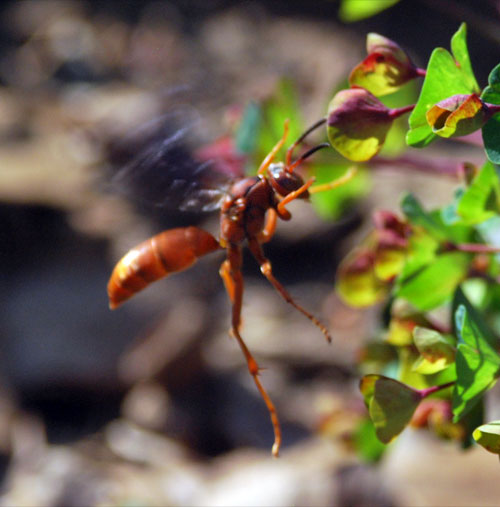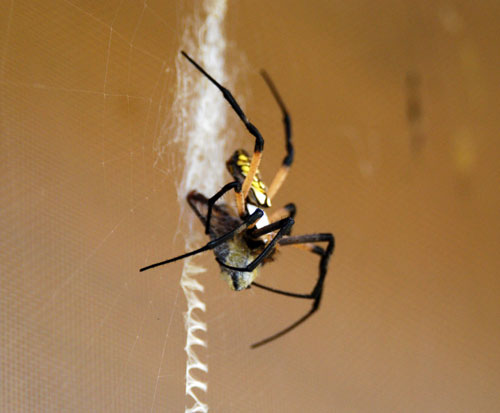
The Red Paper Wasp, Polistes something-or-other, eating nectar from my Blackbird Euphorbias.
The wasps and spiders have begun gathering on my porch, a sure sign that winter is well and truly over.
The numbers this year are somewhat unimpressive: last spring there were hundreds of wasps from three different species gathering under the eaves, while this year I’ve seen only a few, all of them Red Paper Wasps.
The Red Paper Wasps living here are more properly known as either Polistes carolinus or Polistes perplexus — the only difference between the two species, apparently, is some marking on the cheek of the P. perplexus females that is absent on their P. carolinus cousins. Until someone comes up with a better way to distinguish between the two, I think it is very unlikely that I will ever get sufficiently intimate with the creatures to determine which species is which.
During much of the year my front porch is a battleground, with “nature red in tooth and claw” very much in evidence: Large funnel-weaver spiders, Tegenaria domestica, build their characteristic nests in every corner, while even larger black and yellow Argiope aurantia spiders build their giant orb-webs outside the screens; the wasps predate on the spiders, immobilizing the small ones and stuffing them into their nests to feed their larvae (which in turn produce a nutritious saliva that the adult wasps eat), while the larger spiders occasionally snag a wasp in their webs and reduce it to a papery husk over a period of a day or so. To complicate things further, the wasps also capture caterpillars to feed their young; those caterpillars that evade the wasps mature into moths and butterflies that eventually fall prey to the spiders.

Argiope aurantia, wrapping up a little snack for later.
It’s a tough life.
On the other hand, it’s also an elegant and economical system. I do not generally have a problem with caterpillars ravaging my garden, since any serious increase in the caterpillar population results in a corresponding increase in the number of predators, including wasps, that feed on the chubby little morsels. The wasps, meanwhile, die off every winter, leaving only a fertilized queen who will hunker down wherever she can find shelter until spring, when she will begin a new colony.
The name Argiope come from Greek mythology, a nymph who was the mother of a legendary storyteller and musician. Argiope spiders see very poorly: males communicate with females by plucking the strands of their webs like the strings of a musical instrument.
The spiders, mostly funnel-weavers, Tegenaria domestica, also die out in winter, although the females can live for several years in a protected place. The Argiope mother produces an insulated egg sac late in summer which she protects for as long as she can, until winter cold finally kills her. Inside the sac her young hatch out during the fall months but then have to amuse themselves however they may until spring, when they can finally emerge from the bag to complete their growth. The Tegenarias are capable of inflicting a nasty bite, but are generally very reluctant to do so, conserving their venom for prey rather than using it for defense; the Argiopes, on the other hand, despite their size, almost never bite larger creatures, and their venom actually has some medicinal importance.

The Argiope’s egg sac, with my finger to provide scale.
I’ve never found a reason to fear or even dislike these creatures: they’re only around for a few months out of the year, and they do a lot to keep my home clear of bothersome flies and mosquitoes. It’s true that, from time to time, more sinister players wander into this menagerie: black widow spiders live among the rocks along the edges of the flower beds, yellow sac spiders inhabit the pants that I only wear for weddings and funerals, and European hornets, Vespa crabro, (they got off the boat in NYC in the mid-1800s and have been spreading ever since) show up now and then. (Oddly enough, I almost never see the native American version, the Bald-Faced Hornet, which is marked in white on black, rather than the yellow on black of the European species.)
In Germany hornets are so valued as predators to control insects that damage crops that a person found guilty of destroying a nest can face a fine of up to 50,000 euros.

Latrodectus mactans, the Black Widow, and yes, that’s my finger for scale.
Sharing one’s home with wildlife can always demand a certain amount of patience and tolerance, as anyone with pets will tell you. Allowing your home to become a battleground for the forces of evolution, on the other hand, might even be interpreted as peculiar: I don’t know. Sometimes I think it would be nice not to have to give up a part of my personal space every year to an assortment of creatures all hell-bent on destroying each other, even as I go out of my way to avoid doing just that.
All in all, though, I find the good outweighs the bad: For someone who spent his childhood with Wile E. Coyote and the Roadrunner there’s a certain amount of entertainment value in all this predator vs. prey mayhem. Even without falling anviIs, I enjoy the show.
Also, I’ve been stung by wasps only maybe five times in my entire life, and bitten by a really toxic spider only once,and I’m not really all that careful.
As house guests go, I’ve seen worse.
All photo taken by me, in and around my house.
* * *



Leave a Reply